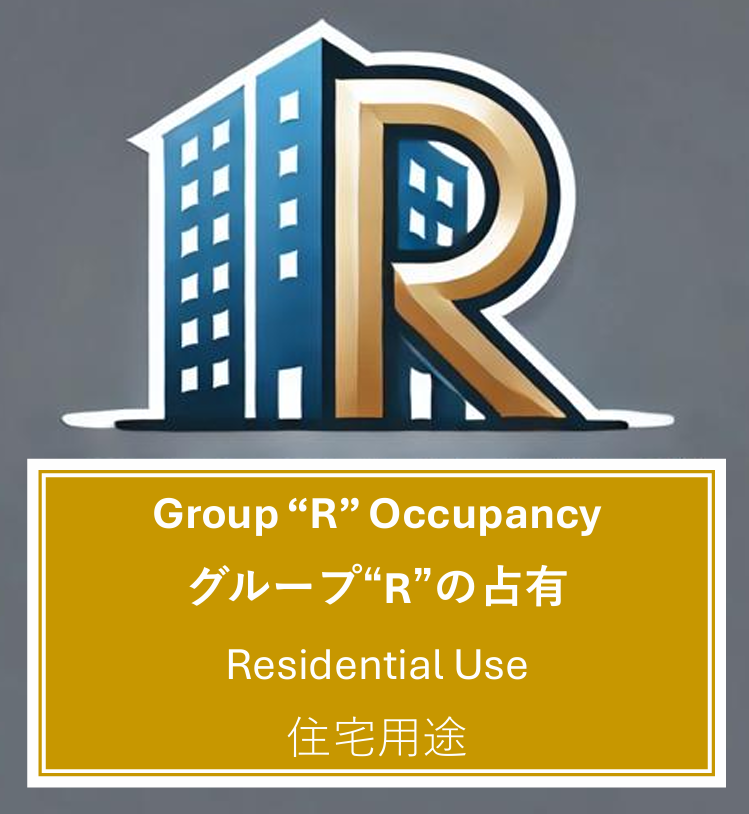
General Definition
- Residential Group “R” Occupancy includes buildings where people live and sleep, covering dwellings, apartments, hotels, and group housing.
- Both the International Building Code (IBC) and Japan’s Building Standard Law (BSL) classify residential buildings based on occupant type, size, and fire safety needs.
- However, BSL enforces stricter fireproofing (耐火建築物), seismic stability, and space efficiency requirements due to Japan’s urban density and earthquake risks.
Residential Group R-1 Occupancy
- Boarding houses (transient) with more than 10 occupants
- Congregate living facilities (transient) with more than 10 occupants
- Hotels (transient)
- Motels (transient)
BSL Occupancies Corresponding to IBC Group R-1
- ホテル (Hoteru) – Hotels
- 旅館 (Ryokan) – Traditional Japanese Inns
- 簡易宿所 (Kaniya Shukusho) – Guesthouses / Small Lodging Facilities
- 民泊 (Minpaku) – Short-Term Rental Homes (Regulated under the Minpaku Law)
- 宿泊型研修施設 (Shukuhaku-gata Kenshū Shisetsu) – Lodging-Type Training Centers
Click the button below to access the applicable codes guidelines:
IBC Residential Group R-2 Occupancy
- Apartment houses
- Congregate living facilities (non-transient) with more than 16 occupants
- Boarding houses (non-transient)
- Convents
- Dormitories
- Fraternities and sororities
- Monasteries
- Hotels (non-transient)
- Live/work units
- Motels (non-transient)
- Vacation timeshare properties
BSL Equivalent Occupancy Classifications for IBC Group R-2
- 用途区分 (Use Classification) “共同住宅” (Kyōdō Jūtaku)
- 寄宿舎 (Kishukusha) – Dormitory
- 学生寮, Gakuseiryō – Student Dorms
- ホテル (Hotel) or 旅館 (Ryokan)
- 宿泊施設 (Shukuhaku Shisetsu – Lodging Facilities), Live/Work Units
- 共同住宅 (Kyōdō Jūtaku) or 事務所併用住宅 (Jimusho Heiyō Jūtaku – Mixed-Use Residential and Office)
Click the button below to access the applicable codes guidelines:
IBC Residential Group R-3 Occupancy
- Buildings that do not contain more than two dwelling units
- Care facilities that provide accommodations for five or fewer persons receiving care
- Congregate living facilities (non-transient) with 16 or fewer occupants
- Boarding houses (non-transient)
- Convents
- Dormitories
- Fraternities and sororities
- Monasteries
- Congregate living facilities (transient) with 10 or fewer occupants
- Boarding houses (transient)
- Lodging houses (transient) with five or fewer guest rooms and 10 or fewer occupants
BSL Equivalent Occupancy Classifications for IBC Group R-3
- 長屋 (Nagayā – Row House) or 一戸建て住宅 (Ikko-date Jūtaku – Single-Family Detached House)
- 福祉施設 (Fukushi Shisetsu – Welfare Facility)
- 寄宿舎 (Kishukusha – Dormitory)
- 簡易宿所 (Kani Shukusho – Simple Lodging)
Click the button below to access the applicable codes guidelines:
Residential Group R-4 Occupancy
- Alcohol and drug centers
- Assisted living facilities
- Congregate care facilities
- Group homes
- Halfway houses
- Residential board and care facilities
- Social rehabilitation facilities
BSL Equivalent Occupancy Classifications for IBC Group R-4
- 福祉施設 (Fukushi Shisetsu – Welfare Facility)
- 福祉施設 (Fukushi Shisetsu – Welfare Facility)
- 福祉施設 (Fukushi Shisetsu – Welfare Facility) or 寄宿舎 (Kishukusha – Dormitory)
- グループホーム (Gurūpu Hōmu – Group Home) or 福祉施設 (Fukushi Shisetsu – Welfare Facility)
- 障害者グループホーム (Shōgaisha Gurūpu Hōmu – Group Home for Disabled Persons) is a recognized category in Japan.
- 更生保護施設 (Kōsei Hogo Shisetsu – Rehabilitation Facility)
- 福祉施設 (Fukushi Shisetsu – Welfare Facility)
- 更生施設 (Kōsei Shisetsu – Rehabilitation Facility) or 福祉施設 (Fukushi Shisetsu –
Click the button below to access the applicable codes guidelines:
Key Differences:
- IBC defines Group R into four subcategories (R-1 to R-4) based on occupant type and supervision needs.
- BSL classifies residential buildings based on their function, with stricter fireproofing for large multi-family dwellings.
- BSL separates hotels (旅館) from residential housing, whereas IBC includes them under R-1.
- Both codes emphasize fire safety, but BSL prioritizes seismic stability due to Japan’s earthquake risks.
